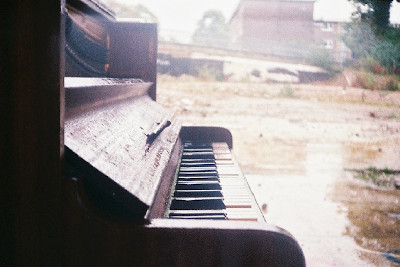
Installations
7 miniatures in stereo (2018)
Video documentation from the first installation of ‘7 miniatures in stereo’. Installed as part of 2021 Concerts cross arts event Perception at A.P.T Gallery, Deptford, London in May 2018.
7 miniatures in stereo is a suite of short fixed media pieces designed to be played back simultaneously in a gallery space. The piece is an exploration of the gallery space of the medium, questioning its suitability for the exhibition of sound. This was in part inspired by accounts and reviews of the first major sound art exhibition in the UK: Sonic Boom which took place in the Hayward Gallery in 2000. Many of these reviews and accounts focus on the interaction between the various exhibits and how some artists tried to minimise this. 7 miniatures in stereo takes the problems and limitations of Sonic Boom and makes them the focus of the piece.
More details
In many ways, this piece is designed to fail. When installed in a gallery the speakers that play back each miniature are positioned throughout the gallery as if sculptures, some on plinths, some on shelves and some on the floor. Each set of speakers is accompanied with a small, gallery style label with the name and duration of the miniature that is being played printed on it. Visually this piece is set up in a way that is very familiar to gallery visitors, it mirrors exhibitions of paintings and sculptures. Sonically, each miniature is based on a single separate sound with no immediately obvious links between the chosen sounds. The piece is designed to encourage a visitor to the gallery to perceive each miniature individually, to portray the impression that the compositional intention of the piece is that of seven separate works that form a whole but do not interact. However, due to the nature of the gallery as a medium for sound, perceiving the work this way is incredibly difficult, if not impossible.When a listener approaches a miniature within the gallery the noise from the other miniatures and the visitors within the gallery impacts the listeners ability to clearly perceive that miniature. It combines with the sound they are trying to listen to, occasionally obscuring it but also interacting with it. By creating a situation that is impossible for the listener, the listeners focus is directed towards the noise, highlighting the impact it is having on the listening experience. Here, the noise of the gallery space is utilised in order to alter the listeners perception of the piece.
dada, gabsus (2018)
Binarual audio, please use headphones.
The same 24 minute soundwalk around the indigenous Kuna community of Armila, Panama, was recorded 24 times, once each hour of the day. This has been edited together into a sonic time-lapse taking the listener through a day-night cycle every 24 minutes. Completely different sonic environments exist all over Armila, often mere metres apart: the still of the jungle at night, the roaring sea, children laughing, the hum of petrol generators and the booms of Reggaeton all permeate every day life. The sped up time frame of the piece is designed to warp perspective; rather than being viewed as an exercise in acoustic ecology, dada, gabsus can be understood as a personal response to the vast, often overwhelming sound world of Armila.
First exhibited at Wild Within, Guest Projects, London 21.07.2018 – 08.08.2018
Untitled Suite (2015)
Video of Movement One the installation in Hallam Tower
Untitled Suite is a duo of pieces composed to explore and reflect the idea of abandoned space through sound. It was composed as part of the Spatial Resonances project in collaboration with the University of Sheffield School of Architecture and the Sheffield Modernist Society. It is written in response to the modernist icon Hallam Tower. The work explores the relationship between abandoned buildings and unwanted ‘dead’ pianos.
Movement One was an installation within the now demolished Halam Tower hotel building in Sheffield a once iconic hotel that had been abandoned and left to rot. The installation took the form of a damaged and unwanted piano that was left in the space. Fitted with motors the piano would sporadically play itself whilst a speaker inside the piano played notes that were no longer playable on the piano. The installation was documented as a film which can be viewed above.
Movement Two takes the form of a fixed media composition, composed utilising sounds from the installation. This movement first focuses on the potential for both to have a purpose again before this is broken up and drowned out by noise suggesting their inevitable demise